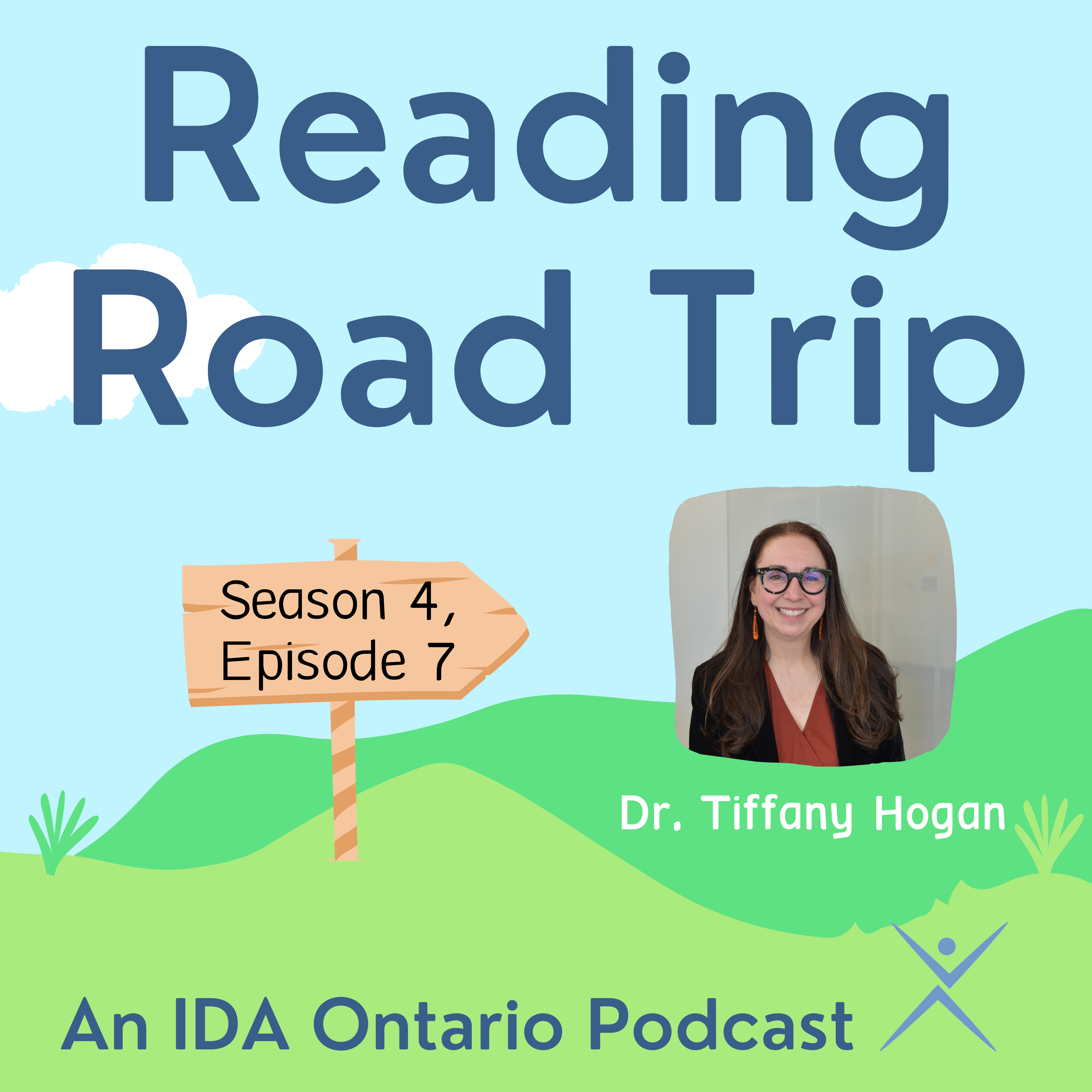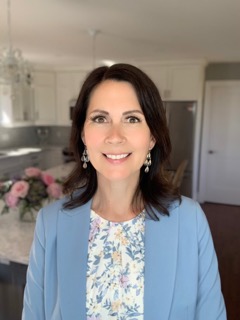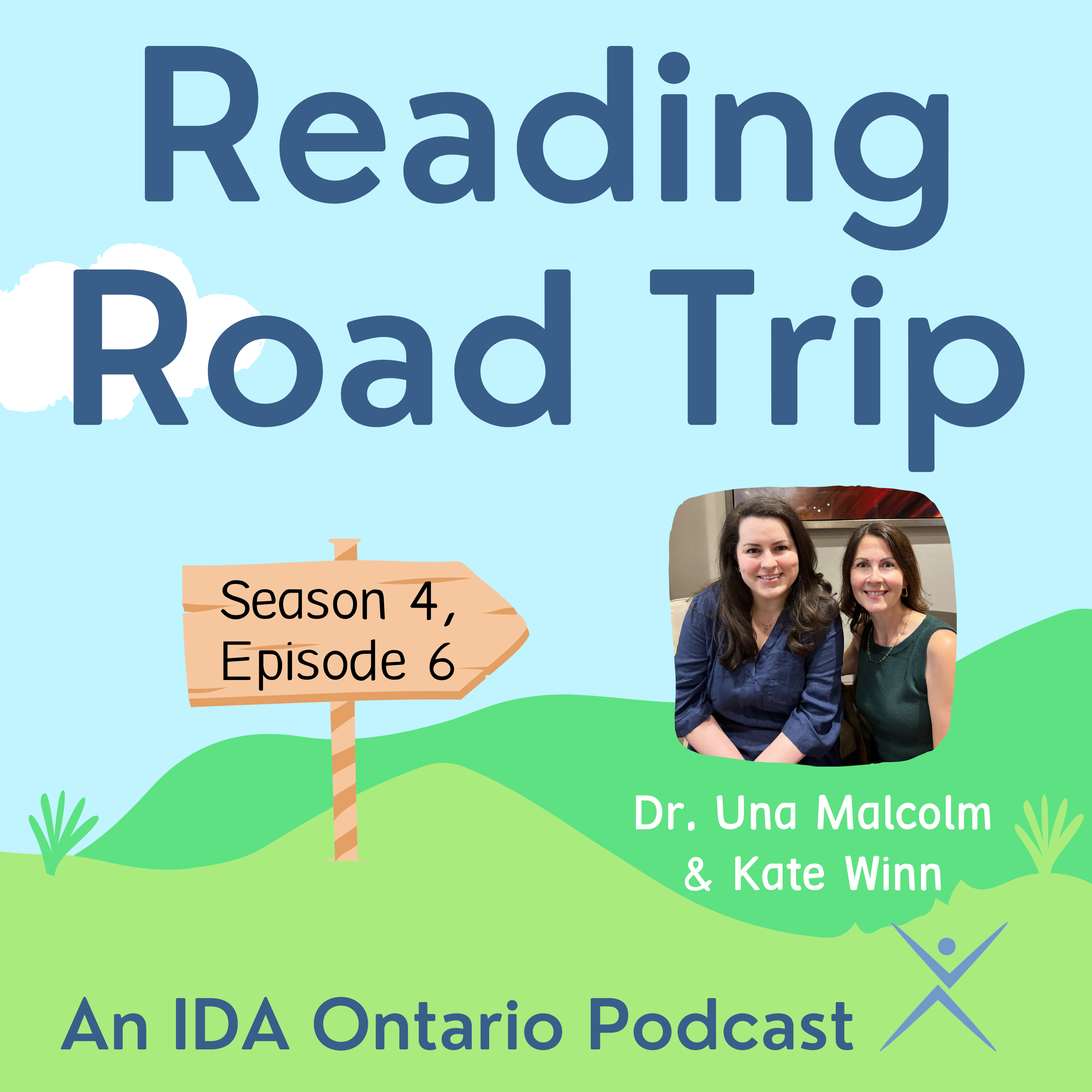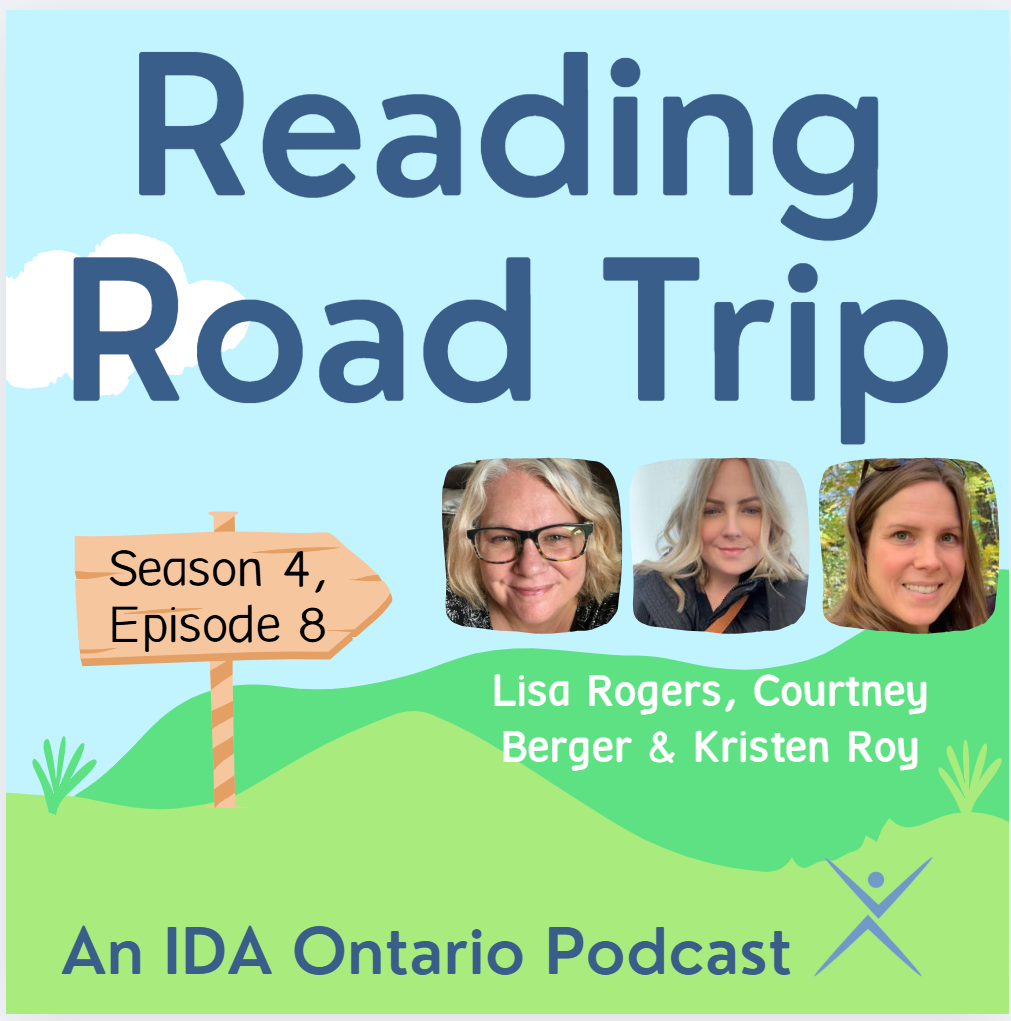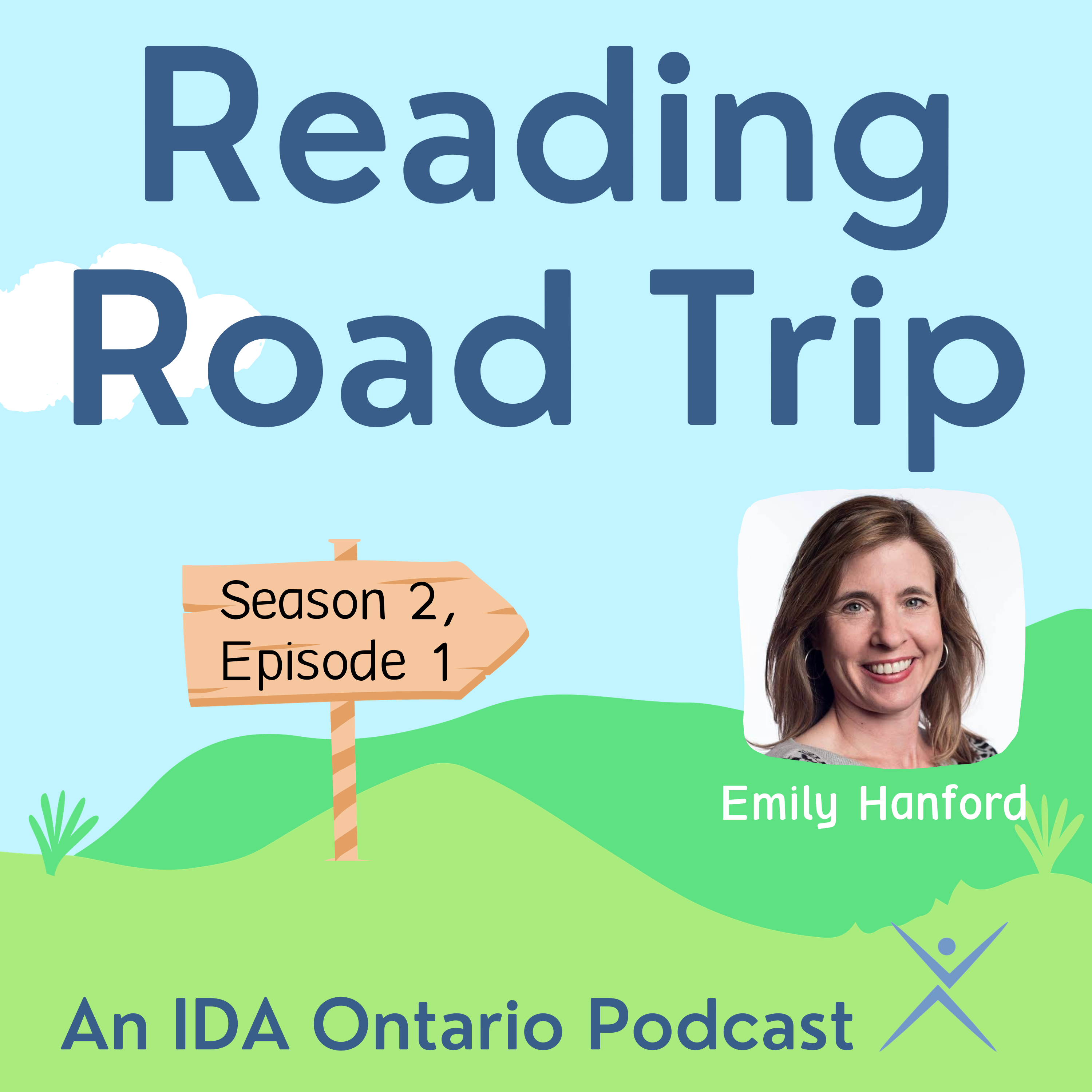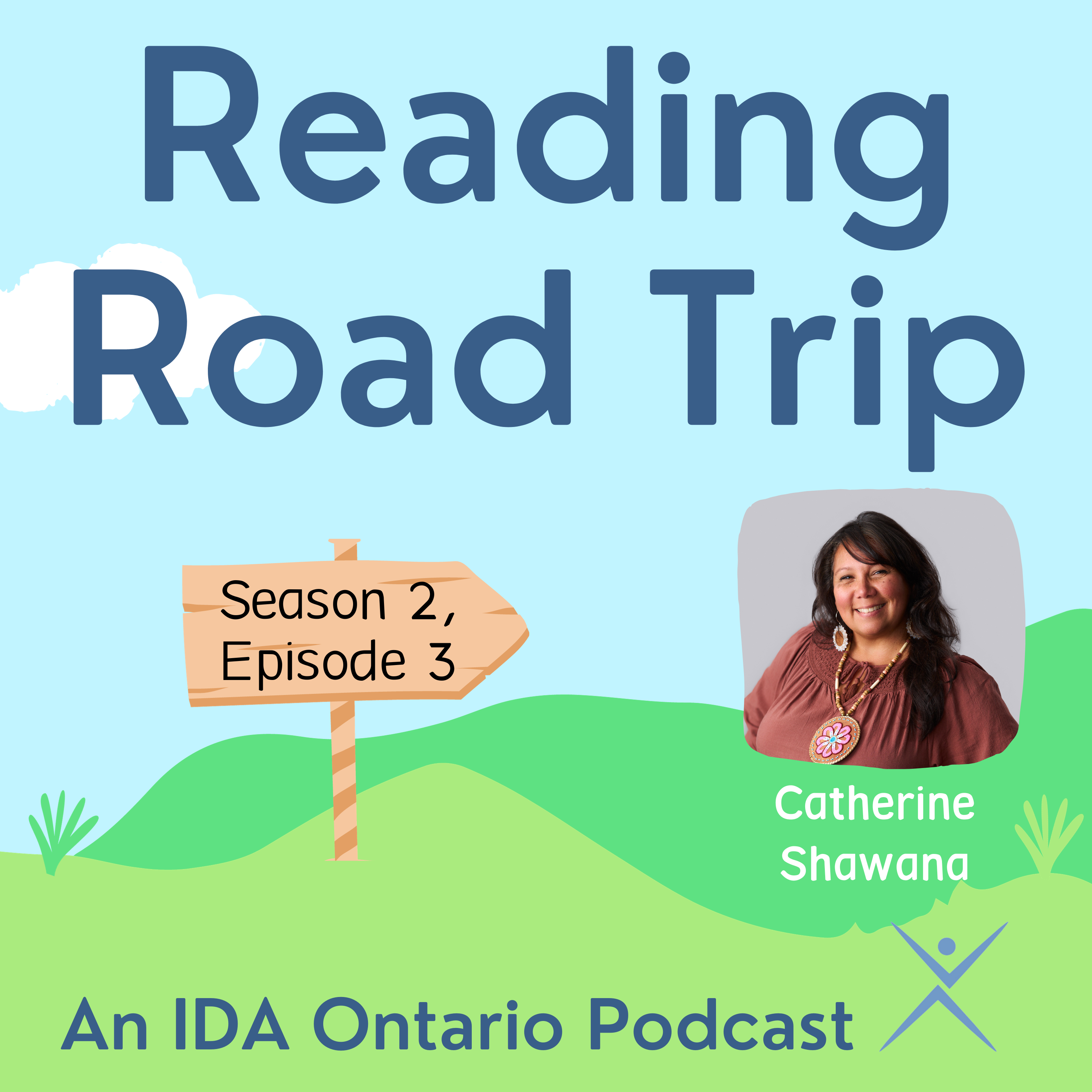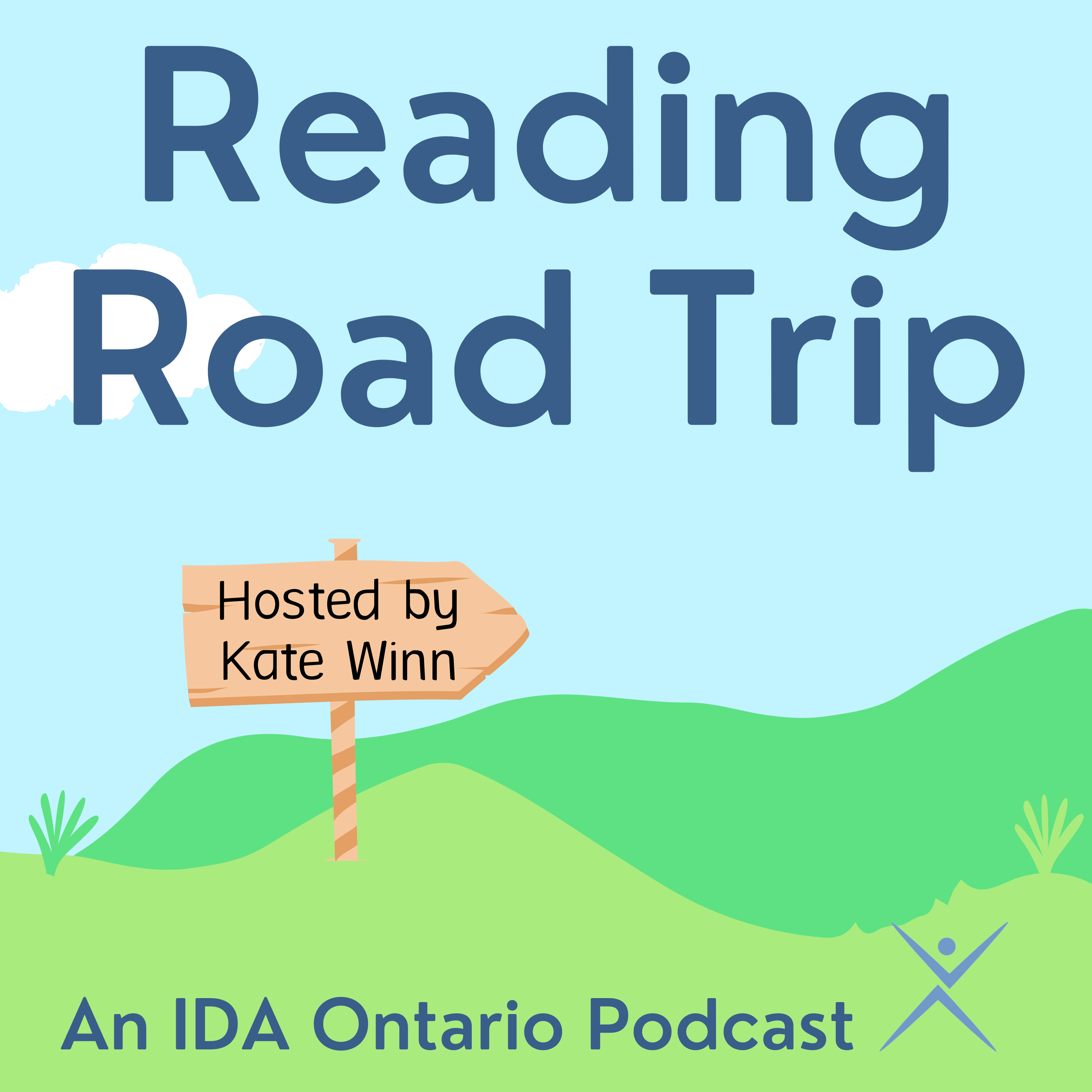Episode Transcript
[00:00:05] Kate Winn: Hello to all you travelers out there on the road to evidence-based literacy instruction. I'm Kate Winn, classroom teacher and host of IDA Ontario's podcast Reading Road Trip. Welcome to our seventh episode of season four.
Before we get started, we would like to acknowledge that we are recording this podcast for from the traditional land of the Mississauga Anishinaabe. We are grateful to live here and thank the generations of First Nations Peoples for their care for and teachings about the Earth. We also recognize the contributions of Métis, Inuit and other Indigenous Peoples in shaping our community and country.
Along with this acknowledgement and in the spirit of truth and reconciliation, we'd like to amplify the work of Indigenous artists and today we are sharing the picture book Miya Wears Orange written by Wanda John-Kehewin, illustrated by Erika Rodriguez Medina.
A beautifully illustrated book that gently explores the complicated feelings a young girl experiences as she learns about tragedy and injustice.
Miya loves her school and she especially loves storytime. One day her teacher shares a story about a little girl who was taken away to a residential school.
The little girl wasn't allowed to go home, her hair was cut and she wasn't allowed to keep her favorite doll. She was taken away from her family because she was Indigenous, just like Miya.
Miya worries the same thing will happen to her. Her mom tells her that Indigenous girls and boys aren't forced to leave their families anymore. Miya is relieved, but she is still sad. What can she do about those feelings?
Add this title to your home or classroom library today.
And now on with the show.
[00:01:47] Kate Winn: I am very excited to welcome our guest here this week on Reading Road Trip, Dr. Tiffany Hogan. She is a professor in the Department of Communication Sciences and Disorders at MGH Institute of Health Professions in Boston, director of the Speech and Language Literacy Lab and the Center for Translational Research, Implementation Science and Dissemination for Equity, and Research Associate at Harvard Medical School. Dr. Hogan has published over 100 papers on the genetic, neurologic and behavioral links between oral and written language development with a focus on improving assessment and intervention in schools, especially for neurodiverse children with developmental language disorder, dyslexia and or speech sound disorders. Her advocacy for children with language, speech and literacy disabilities has led her to co-found a DLD informational website, www.DLDandme.org, host a podcast www.seehearspeakpodcast.com and contribute information for articles in numerous news outlets including the New York Times and the Boston Globe. That's quite a bio. Welcome Dr. Tiffany Hogan.
[00:02:56] Dr. Tiffany Hogan: Oh, I'm so glad to be here. Thank you so much for having me.
[00:03:00] Kate Winn: So I'm really excited to dig into our topic today, which is developmental language disorder. It has come up, you know, in some of the episodes of the podcast we've had, but we haven't done a deep dive and a full episode on it. And we thought you would be the perfect person to help us dig into this one. I think the best way to start just to ask you to explain what is developmental language disorder?
[00:03:21] Dr. Tiffany Hogan: Developmental language disorder is when a person has difficulty using or understanding language. It is a neurodiversity, meaning that a child is born with a brain that makes it difficult for them to learn language, whether it's their first language, second, third language. In particular, we know that children with DLD have difficulty learning vocabulary, words, and grammar, which is morphology and syntax. What we know also from multi-generational studies and longitudinal studies is that children with DLD will develop language in a sequence that's like they're typically developing peers, but they tend to be late in their milestones.
So they will develop language, they will start talking late, and they will be behind in their developmental milestones, but they make progress. And, and they do benefit from having rich language instruction and accommodations to support the best use of language that they do have in the schools.
[00:04:19] Kate Winn: Great. And I know later on we're going to get into some of the things teachers can do. I do want to mention for our listeners here in Ontario who might be thinking, oh, never heard of that. I don't think I've ever taught a student with this. We'll be talking about prevalence as well, but in Ontario, the category for identification for a student with DLD would be communication language impairment. So if you're thinking, I've never taught one of these students, you've probably taught a student identified with a language impairment. So that's the same kind of thing we're talking about here. The next thing I want to ask you is taking a look at the simple view of reading, I know we never want to simplify anything too much, but if we're looking at that word reading piece and then we're looking at that language comprehension piece, is it generally accurate to say that if it's the word reading issue, we may be looking more towards something like dyslexia. If it's the language comprehension issue, maybe looking towards something more like DLD, it's possible for a student to have both, and of course, possible for a student to have neither. Is that generally accurate?
[00:05:15] Dr. Tiffany Hogan: Absolutely. Yes. You said it so perfectly. Yes. And what we see in terms of language comprehension difficulties is that DLD is one of the reasons that we might see a child struggling with language comprehension because they have this neurodiversity that makes it difficult for them to understand language at the expected range you would expect for their age. We also see a high overlap with dyslexia. So DLD and dyslexia are highly comorbid, meaning that if a child has DLD, they're very likely to have dyslexia and vice versa. That comorbidity, if you think about kind of the range, it's going to be about 50 to 80% and even higher in some clinical populations. So if a child is being seen and already identified as having dyslexia, and it's so important to check to see if they have DLD and vice versa.
[00:06:05] Kate Winn: And how prevalent is DLD by itself?
[00:06:08] Dr. Tiffany Hogan: DLD prevalence is around 10% of the population, which means that's about one to two children in every classroom. And using the census data from public schools in the US we know there's about 5 million children who have DLD. So it's very prevalent, and it runs about the same prevalence as dyslexia.
[00:06:29] Kate Winn: Okay, thank you. Is there a cause for DLD? Anything that can be done in terms of prevention, anything like that?
[00:06:36] Dr. Tiffany Hogan: Great question. So DLD does tend to run in families, so we know there's likely a genetic aspect to it, but we do not know the specific cause of DLD. It's likely a neurodiversity that's happening in the human brain. We know that DLD exists in all languages that are spoken, so it is something that happens as part of the human condition.
We also know that early intervention is helpful for children with DLD. So the more that they get support for their language, the better they do long term over time. But language and language acquisition and understanding will always be a difficulty for children who have DLD, and we need to think about supporting them across the lifespan.
[00:07:23] Kate Winn: As teachers, what can we look for to help spot DLD? If we start, you know, I teach kindergarten, so if we start with those incoming students, the first that we get them as, you know, official teachers, what are we looking for? We can talk about assessment in a minute, but in terms of, like, general observational look fors, what might we see?
[00:07:39] Dr. Tiffany Hogan: Yes. So we've worked with many, just school districts, and we talk to teachers and parents and we try to capture this exact information. Like, what are some of the characteristics you'd see in these children?
First, you might think one characteristic is that they've been in speech and language services prior to kindergarten. That is a definite characteristic, but it's not the primary one because many of these children are hidden and they're not identified. So we only have about 20 to 30% of children with DLD that are ever identified for support services. So we have to look for these other subtle characteristics. Some of the characteristics we've heard about is that they are hesitant, so they might be one children that kind of sit back and let others answer questions. They will look around to their peers to see what responses they're giving. They may look to their peers when they're given instructions. So they're trying to gauge what are my peers doing. Multi step instructions are very difficult and they're very common in the classroom, even in kindergarten.
[00:08:40] Dr. Tiffany Hogan: So they may understand the first step and then not the next steps and they'll look around. They also are unclear in telling stories. And we know storytelling is a human interaction that happens all the time and they are, you know, telling stories that aren't quite clear. So you might not know the sequence. Is it a little off? Where's the setting? Who's the, who's the characters in this story? Even if they're telling you about what they did this weekend, it's just very unclear like who was involved and. And they kind of might start in the middle or might leave out key details. They also tend to drop off sentences. So they might start telling you a sentence and just drop off. And not in maybe a normal pausing spot but just kind of in the middle, just really drop off. They have word finding difficulties, so they may try to say a word and not know what it is so they may describe it or they may switch course and use a different word.
They also can have grammatical difficulties, so they may have grammar that is more immature. So they may leave off inflectional markings. So instead of saying he is running, they may say he run. And so they're leaving off some of these markings that you might expect for a child in kindergarten.
[00:09:51] Kate Winn: Would we be worried, in terms of articulation difficulties, how does that connect? I didn't warn you I was going to ask this one but it just popped into my mind. How does that usually connect, or does it to DLD?
[00:10:03] Dr. Tiffany Hogan: Oh, I'm happy to answer that because it is confusing. Speech and language development is so complex. With language we think more about the content of language, which is vocabulary and grammar. With speech we think about articulating speech sounds. So children with DLD can have co occurring speech sound difficulties, where their speech is more immature, they make more speech errors than their typically developing peers, but they are separate conditions. It is tricky because oftentimes when we think about having speech and language difficulty, we think about the speech first because it's very overt. It's the thing we notice.
But with DLD, it's really, we're looking at that content, so the vocabulary and grammar and how they're telling stories and how they're getting their message across.
[00:10:50] Kate Winn: Okay. In terms of actual assessments that might help us identify DLD, I know you were so kind to have a phone call with me to help me wrap my mind around some things for the book that I'm working on with Dr. Stephanie Stollar on reading assessment. And I don't want to speak for Dr. Stollar, but I can speak for myself that I feel much more comfortable and better versed in assessing the word reading side of things, right. And so if we start with screeners, is there anything out there yet that you would recommend, like, for at the teacher level? Any screeners that teachers could use to help identify DLD?
[00:11:23] Dr. Tiffany Hogan: Yes. So there's much fewer screeners than there are for reading and for word reading we see screeners are really implemented, you know, pretty consistently, at least in the US we see teachers giving word reading assessments. They give them over time during the school year. They use them for instruction. We don't have that as much for language, but we do have some language screeners that are coming out, especially in the last decade and my colleague Xu Bao and I published a paper that's Open Access, it's a review of DLD screeners. It's a couple of years old now and things have been added since. But I get asked this question quite a bit, and what I'll say is that it really depends on where you are. It's the age of the children you're working with, the resources you have in your context. You know what? How do you want to integrate screening into your daily practice, and not daily, but your yearly practice, like you would in terms of progress monitoring. So this is a, I'm not trying to skirt the issue, but I just will say there are several highly accurate and reliable screeners out there. And maybe we can link that in your show notes for your listeners, because I think that it's really worth taking a look at what's out there. You have a great one there in Ontario that I believe is recommended the PELI. I never know if I'm saying that right, and that's actually in our review of screeners as well. It's highly accurate and is a great, you know, great resource there for use for screening. Screening can come in many different forms. There's parent questionnaires, you can ask parents questions, they can fill out the questionnaire and that can be highly accurate. You can also have screeners where teachers are administering those screeners, individual, excuse me, individually with children to get information.
And we also have group screeners that are starting to emerge too. So a group of children in a classroom could be administered a screener as a group, which is very efficient. And screeners typically will ask about family history, about difficulty with language, about early development, if there's a parent screener. And they're also, if you're thinking of a classroom screener, they're going to look at story retell is a big one. So asking a child to retell a story and then taking notes on how accurately they retold the story, what was the vocabulary they used, what was the grammar. There's also sentence repetition and that's asking children to repeat sentences that are more and more complex. And that's very helpful to determine the information that a child has as they're listening to a sentence and able to repeat it.
There's also assessments of complex grammar.
[00:13:58] Dr. Tiffany Hogan: So, you know, having a child listen to a complex sentence, maybe combining two sentences and then having them pick the picture that represents that complex sentence is another way we can measure language skills. So there's one measure that's very promising, that's out more recently is Language Screen. That was developed out of the UK, but is being normed in the US and other places, and that's a really great measure in the sense that you can use it multiple times and get a progress monitoring type of data, which is great to see how children are learning language in the classroom. And another one is the CUBED assessment.
And that one has again, multiple progress monitoring measures that you can use over time to see how well a child's learning. Because ultimately, when we think about screening, we're most interested in how children are learning language over time. So screening gives you a snapshot. But as we know in Multi Tiered Systems of Support, we really are interested in getting the snapshot to see who's at risk, but ultimately providing them strong support in language or word reading, depending on their difficulty area, and then measuring again to see what improvement they've made. So I'm most excited about measures of language that you can give multiple time points, especially when we think about multilingual children who need measures, ideally in their first language, but if we don't have those measures, we're going to have to use other measures, perhaps in the language they're using in the classroom and then look to see how well they're learning language in terms of vocabulary and grammar throughout the school year. It's really that slope of learning, that response to intervention that will tell you if they have difficulty or not.
[00:15:41] Kate Winn: Thank you. That was a very thorough answer. I've jotted down a couple more things I wanted to mention from that. Thank you for mentioning PELI. For one thing, I did to mention that to listeners as well because I know in Ontario early reading screening is now mandated for the second year of kindergarten, grade one and grade two. A lot of people are screening beyond that.
But in kindergarten it's very word reading based. But for PELI, which is our year one, which some would call pre-K, depending where you are, you can use this tool. And what's different about it is it does have the vocabulary oral language measure to it and the listening comprehension measure. So not just word reading piece, you're actually getting some of that language comprehension piece from that. So I find that really, really valuable information to get early on about these kids. You know, like this year I had a couple of reds and I knew, okay, this is something we need to get on. And parents can be so supportive when they have that information too. So that's great.
And even how you mentioned retell, I think sometimes we think, oh, we don't have any tools that are going to help us. But once your students are doing an oral reading fluency assessment, if there's a retail component, you are getting something from that. And then of course the things that about fluency, connecting to comprehension and, and all of that too.
When we talk about the word reading side of things, we usually say, okay, screeners. And then the kids who are at risk, we're going to move them to a diagnostic. And so again, not as many things that we have access to in the area of language comprehension because if it's word reading, there are different, you know, phonics diagnostics we can use determine what the problem is. A bit harder with diagnostic, there are things like acadience, has a CFOL comprehension fluency, oral language, and it does have some of those pieces in it to help us maybe target instruction where some of the weak links are. But if we're actually talking about diagnosing DLD, would it be accurate to say we probably want a speech language pathologist sort of as part of this, this isn't a teacher thing.
[00:17:30] Dr. Tiffany Hogan: Exactly. So teachers play such important roles in identifying children who are struggling in the classroom with language and supporting them in the classroom. But ultimately diagnosis at this time point is really needing to be given by that speech language pathologists through a comprehensive evaluation. That usually involves a comprehensive evaluation of language which is required for diagnosis of DLD. And also to purchase that assessment, to interpret that assessment, to administer, you need to have the credentials of a speech language pathologist to do that.
And also you might want to give a language sample which is so informative and really gives you that ultimate kind of how are they using language in functional ways? And, and classroom observations, parent report all of these things in a comprehensive evaluation will give you more accuracy and confidence in a diagnosis of DLD by a speech language pathologist.
[00:18:26] Kate Winn: If this gets missed in the early years of schooling, what would be warning signs that a teacher might spot in a student in an older grade? Is it anything different from what we might see in the early years?
[00:18:37] Dr. Tiffany Hogan: That's such a great question. And because we know that for the past 30 years, since it was first documented, we see that children with DLD unfortunately are missed for early diagnosis and support.
Some of that is because of the focus on word reading and because about 50% of children with DLD that can read words well, they're the ones that are really most likely to be missed. Although there are children who have dyslexia who are also missed as having DLD.
So identifying these children later in the school years is not uncommon. I'd say it's more common. And what we tend to see is that these are the children who look like they're doing well in the early grades. They're reading words. They might even be answering comprehension questions, okay.
And they're just not raising these major red flags. However, when they hit the later grades, you see that when they're asked to do more higher level comprehension tasks, they really begin to break down so they can read the words, but they're struggling to comprehend the more complex language that's in those passages. And that's when we start to see it arise.
They look like children who are late emerging poor readers in third or fourth grade. In the US what we found in our research is that these children are not late emerging poor readers. They're actually late identified. When we look longitudinally at early language that we may have measured in longitudinal studies, we see that they always had language difficulty, but the focus was on word reading.
[00:20:07] Dr. Tiffany Hogan: And because reading comprehension assessments in the early grades are constrained by the words that children can read, the language measured in those reading comprehension tests early on, they're just not that hard. So children with DLD can pass those early reading comprehension assessments as long as they can read the words, because the language is not that taxing. Once you get a little bit older, then you start to see that the language catches up with what you would expect in everyday conversation, in academic language, and then you can start to see them to break down.
[00:20:39] Kate Winn: Okay, what can we actually do as teachers in the classroom? We have a student with DLD, suspected to have DLD, my understanding is that perhaps it's different from dyslexia in the sense that the goal isn't for them to catch up, but other things to do to support them, to help them with their achievement. What do you suggest?
[00:20:58] Dr. Tiffany Hogan: Yes. So, first off, there's a lot that teachers can do to support children with DLD, and I would say they might be the most important support that a child with DLD has. Because children spend the majority of their waking hours in school, and especially when they're in the early grades, they're spending it with their primary teacher.
What can teachers do? First, do some research on DLD. Understand what it is. Recognize that these children may look like they're hesitant. They may look like they're struggling with some peer interactions, and it's, and they sometimes even appear very emotional, because they feel frustrated that they can't express what they need. They can appear to be behavior difficulties because they can't get their needs met. And so first, recognizing that if a child is showing that type of profile, digging deeper, because we know that children are always doing the best they can. So if we can't figure out what it is, language could be a real culprit here. So really thinking about that first and foremost, and then I would say there's kind of two levers to push when you're thinking about support. The first lever is accommodations. And this is, you know, typical accommodations you might give any child with learning disabilities. So you want to give them extra time, ideally, having them sit closer to the teacher so they have, you know, more attention, kind of focus. They can ask questions, they can clarify. You want to reduce the burden of language. So you don't want to have five step directions. You want to do one or two step directions, pause, make sure the child understands, even have them recite it back to you. What are you supposed to do? Giving them those cues, giving visual cues of routines and what's to be expected.
Very, very helpful. And with children with DLD and dyslexia, even if they have difficulty in word reading, providing them a written form of a word that they're learning is extremely helpful for them to recall it, even if they're just learning how to say the word. If you provide that written form, it's very helpful because speech is transient, it's kind of in and out and you have to hold it in your memory, whereas written is stable. And so we see that if you write it down, it's very helpful. That's directions, new words, grammar, anything you can do to give visual support is very, very helpful for children with DLD. The other lever you can push is to provide more direct support for language. So providing multiple repetitions of new words, you know, providing multiple contexts for learning new vocabulary, new grammar. So if you're focusing on past tense verbs, giving lots of different past tense verbs in a session and giving lots of repetitions of those, especially in different sentences, is very helpful for what we know about statistical learning of language. So you can think about accommodations that are going to be more global and you think about really addressing at the heart of vocabulary and grammar and discourse level, like giving them the dosage, the multi sensory input that they need for those language structures.
[00:24:00] Kate Winn: That's great.
[00:24:01] Kate Winn: I think classroom teacher knowledge about the science of reading has evolved. At first we knew nothing, speaking for myself, and then of course that phonics focus, right? And here in Ontario we had the Ontario Human Rights Commission's right to read inquiry, a lot of their recommendations around the world reading piece because we were, you know, failing a lot of kids with that. But we've, you know, evolved to understand, you know, the two pieces of the simple view and the two sides of the rope. And however you want to look at that and understanding the importance of vocabulary. And of course that's going to be really important with these students with DLD as well. We have vocabulary very clearly laid out in our new Ontario language curriculum that goes from grades one to eight. I feel quite confident we'll see it in our new kindergarten curriculum, which is on the way. Would vocabulary instruction look different for students with DLD? And if so, how?
[00:24:46] Dr. Tiffany Hogan: Truly, it's not going to look much different than what we know is a strong evidence base for vocabulary instruction for typically developing peers. A lot like how we know systematic explicit phonics is helpful for all children. The way we want to think about vocabulary in a systematic and explicit way is helpful for all children, including children with DLD. But what we will see with children with DLD is they're going to need a higher dosage of vocabulary instruction. So, for instance, typically developing children can pick up on a new word and remember it, recall the name of a new object and the meaning behind it in one to two exposures.
So they have very good, what we call fast mapping skills. Children with DLD can take 10 to 20 more exposures to recall that word. They can do it, but it's going to take a lot more exposures, and they're going to be more inconsistent in their recall of that word.
So everything that we want to do for children who are typically developing, we want to lean into that even more in terms of dosage and support for children with DLD.
[00:25:50] Kate Winn: Great. Are there any specific resources or programs that you suggest teachers use in the classroom? I'm thinking, you know, there's the whole class aspect. I'm also thinking, okay, I've got these two kids who look to me to be at risk on that screener. Do I pull them? Is there something I use? Or even, you know, special education teachers, is there value in them withdrawing students to do any sort of intervention, you know, teacher level? Are there resources you suggest?
[00:26:12] Dr. Tiffany Hogan: Yes. So I think that at this point in time, there's a smattering of resources that are available for what I would think of as more whole classroom curriculum that's focused on language. And then there's also a smattering of resources available for small group, more like tier 2 intensive instruction, and then there's resources for special education.
Ultimately, what we want to do is mimic what we've seen work so well in word reading. We want to have really strong classroom instruction, and we want to see that classroom instruction focus on language, and then we want to have progress monitoring that then will tell us individual differences. And when we see those individual differences, we would be able to determine what grouping the child would need based on those scores. So they may need a boost that you might see. They're more subclinical, they're not quite ready to be referred to for an evaluation, but they're not really strong in language. So they're in that borderline, and they need that small group instruction at this time. We don't see a comprehensive program that has everything yet. It's getting very close. I'm very excited. I was talking to publishers, a group of publishers, recently, and they see the benefit of doing this. They know they need to do this. I also think we're going to start to see a systematic approach of MTSS focused on language. So we have MTSS primarily focused on word reading at this Time we have to have the same level of support. And all of those boxes we fill for MTSS for word reading, we have to fill those boxes for language too, to give it its due time.
[00:27:47] Dr. Tiffany Hogan: Because we know that if we only work on word reading and not language, we are not going to see the improvement in reading comprehension that we want to see. This is a long way for me to say that I don't have a specific program that I recommend. I do think that there's some out there and they are focused on language, but we also see that there's a lot of programs focused on knowledge. And I'm often asked, you know, what's the difference between knowledge building and language building? And it's really a focus of attention issues. So a lot of knowledge building curriculum do a great job with language, but maybe it's not their focus of attention. And we see language curriculum that does pretty good job on teaching knowledge, but it's not the focus of their attention. So we want to see that merging. We want to tighten up the language support in knowledge curriculum. We want to tighten up the knowledge support in language curriculum. And we also know that, you know, we need knowledge base. We need something to talk about when we're focusing on language, but we also.
[00:28:45] Dr. Tiffany Hogan: When we're focusing on building knowledge, we need to have vocabulary and grammar to talk about that knowledge and to learn it. So it's really bi directional that way. So, yeah, I think that we should think about holding the standard of language curricula to the standard we have for systematic and explicit instruction in word reading.
[00:29:06] Kate Winn: Thank you. Are there any misconceptions about DLD or anything you want to clarify that we haven't already talked about? I'm sure you hear it all.
[00:29:14] Dr. Tiffany Hogan: Yes, yes. One thing I want to clarify is this link between verbal ability and intelligence. And it's, I think, much more dramatic for DLD than it is for dyslexia. Because intelligence tests are measured by two different subtests, the verbal intelligence subtest and the nonverbal intelligence subtest. And those are put together for a composite. What we know is that children with DLD absolutely will score lower on a verbal intelligence test because that's their area of weakness. So that would be like saying, hey, let's measure intelligence in children by having them read words. We would be up in arms about that. We say, well, that's not a good way to measure intelligence because that's the area of difficulty for children with dyslexia. We should be doing the same thing for children with DLD. What's happened oftentimes is that they are underestimated because if they do receive comprehensive evaluation that does include an intelligence assessment, it will look like they have lower intelligence.
[00:30:11] Dr. Tiffany Hogan: So what we suggest is to measure intelligence through non verbal intelligence and that will give you a better sense. I'm not actually a big proponent of intelligence testing, to be honest, because I haven't seen it be useful for instructional outcomes and I haven't seen compelling data to show me that it predicts who's going to make benefits in word reading or in language.
[00:30:34] Dr. Tiffany Hogan: So I don't propose we do that. But what I will say is, practically speaking, that's what I often hear is they'll say, well, this child didn't qualify for services because yes, they have language problems, but it's commensurate with their intelligence. And then they're seen as not qualifying for services. And that's whether you're using an IQ discrepancy model or just really attending to intelligence as some type of measure for potential. And this is really a major disservice to children with DLD.
[00:31:04] Dr. Tiffany Hogan: And we know even if you use nonverbal intelligence for children with DLD, they still might score slightly lower because there's been studies showing that even nonverbal intelligence tests use a lot of verbal mediation to answer the questions.
I think that the key here is that children with DLD can make progress. They have strengths that are often masked because language is what they're swimming in in the classroom, in every single context area. Science, social studies, math has a lot of language demands. And so we have to think about making sure that we're supporting their language, but we also look for their strengths and try to bolster them. Because I use the example - could you imagine if we were a society that had, for whatever reason, evolved to run everywhere as opposed to cars or bikes or anything, we had to run places. There's some great runners in this world and they are fast and that's easy for them and whatever. There's a range of ability, but I would have a running disability. I'm not a fast runner. And so, you know, disability is, you know, based on a societal construct.
[00:32:12] Dr. Tiffany Hogan: And so if I was in a situation where all I had to do is run and I was just totally judged on my running ability all the time, you know, eight hours a day. It would be so frustrating. I couldn't imagine. And I would feel really like none of my strengths were seen.
[00:32:28] Dr. Tiffany Hogan: And I think we have to think about that with children with DLD is that they struggle with language. But they have so much to offer and they have so many strengths. And we have to build in a focus on those strengths as we're supporting their weakness.
[00:32:41] Kate Winn: Thank you. I just had to laugh when you were giving the running example. I went for a 5k walk yesterday and by the end my hip was kind of doing something funny. So when you said that, I think my hip started hurting just remembering.
Yeah, I would not want to have to run everywhere. And I'm also glad to hear that your thoughts on intelligence assessments kind of are aligned with what Stephanie and I write about in our book as well, because we want assessments that are going to give us practical information to inform instruction so we can move these kids forward. The last thing I want to ask is, do you have any final message you want to give listeners? I know we will definitely link to your website and your podcast in the show notes, but any last words you want to say or anywhere you want to direct us anything you're you've got going on?
[00:33:20] Dr. Tiffany Hogan: Yes. I always leave listeners when I'm giving a presentation or podcast, I've started to do this more and more, is I'd like to leave you with a challenge, and that is to talk or think about DLD at least 5 times this next week. What does that look like? Talking to a peer, talking to a parent you work with, talking to another educator, talking to an administrator, spending time on DLD and Me learning about DLD, looking at resources. We have so many resources for educators, for teachers, for parents, for persons with DLD. Just really wrapping your head around DLD because it is so prevalent, but it is often not known. And you may think like you said in the beginning, you don't see these children, but you see them every day so you are in a position as a listener, you've taken the time to listen to this podcast about DLD. I thank you. I'm honoured for that time. And now you can turn that time into action by thinking about DLD at least 5 times this next week.
[00:34:18] Kate Winn: And if they share this podcast episode with a friend or on social media, that counts as one of the five, right?
[00:34:24] Dr. Tiffany Hogan: You can do that five times. Why didn't I say that? Of course, that's the number one thing.
[00:34:28] Kate Winn: Everybody should hear this. I've learned so much from you in this episode. Dr. Tiffany Hogan, thank you so much for being here with us on Reading Road Trip.
[00:34:37] Dr. Tiffany Hogan: Thank you for having me.
[00:34:44] Kate Winn: Show notes for this episode with all the links and information you need can be found podcast.idaontario.com and you have been listening to season four episode seven with Dr. Tiffany Hogan.
Now it's time for that typical end of the podcast call to action. If you enjoyed this episode of Reading Road Trip, we'd love it if you could rate and or review it in your podcast app as this is extremely helpful for a podcast. And of course we welcome any social media love you feel inspired to spread as well. Remember, Dr. Hogan says you need to talk about DLD. This is your perfect opportunity. Feel free to tag IDA Ontario and me. My handle is thismomloves on Twitter and Facebook, katethismom loves on Instagram and Kate Winn on Blue Sky.
[00:35:28] Kate Winn: Make sure you're following the Reading Road Trip podcast so you don't miss a single episode in this jam packed season. New episodes will be released on Monday mornings all summer long.
[00:35:37] Kate Winn: We couldn't bring Reading Road Trip to you without behind the scenes support from Brittany Haynes and Melinda Jones at IDA Ontario.
I'm Kate Winn and along with my co producer Dr. Una Malcolm, we hope this episode of Reading Road Trip has made your path to evidence based literacy instruction just a little bit clearer and a lot more fun.
